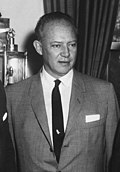This article needs additional citations for verification .(June 2020) |
| |||||||||||||||||
| |||||||||||||||||
 County results Dominick: 50–60% 60–70% 70–80% McNichols: 50–60% 60–70% | |||||||||||||||||
| |||||||||||||||||
| Elections in Colorado |
|---|
 |
The 1968 United States Senate election in Colorado took place on November 5, 1968. Incumbent Republican U.S. Senator Peter Dominick was re-elected to a second term in office over Democratic ex-Governor Stephen McNichols. Peter Dominick defeated Stephen McNichols in a landslide despite Richard Nixon, a fellow Republican to Peter Dominick, winning the state by a somewhat smaller over Hubert Humphrey in the concurrent presidential election.

